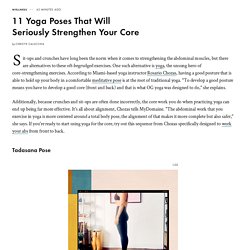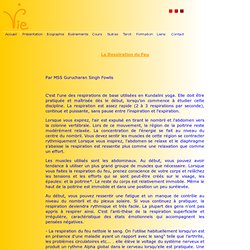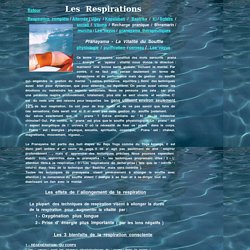

Postures de base du Yoga. YOGA - MUDRA Abandon - Simplicité - Unité retrouvée EXECUTION: 1.

De préférence être assis dans la pose du Lotus ou demi - lotus , ou en tailleur, le dos reste bien droit, les mains reposent sur les genoux. 2. Inspirez profondément. 3. Expirez en vous penchant en avant jusqu'à ce que la tête touche le sol ou s'en rapproche au maximum. 4. Redressez-vous en Inspirant. 5.
Le COBRA (BRUJANGASANA ) J'ai confiance en moi pour faine face aux obstacles J'ai la force qu'il faut pour faine face à la vie Visualiser une lumière bleue au niveau de la gorge EXÉCUTION: 1. La PINCE ( PASCHIMOTASANA ) Fitness, Yoga, and Meditation. Yoga. Yoga. Yoga. Yoga. Yoganini. Yoga. La salutation au soleil, Suryanamaskar. Yoga Postures Step-By-Step - Index to Poses. Here Are 11 Ways to Use Yoga for the Core. Sit-ups and crunches have long been the norm when it comes to strengthening the abdominal muscles, but there are alternatives to these oft-begrudged exercises.

One such alternative is yoga, the unsung hero of core-strengthening exercises. According to Miami-based yoga instructor Rosario Chozas, having a good posture that is able to hold up your body in a comfortable meditative pose is at the root of traditional yoga. "To develop a good posture means you have to develop a good core (front and back) and that is what OG yoga was designed to do," she explains. Additionally, because crunches and sit-ups are often done incorrectly, the core work you do when practicing yoga can end up being far more effective.
It's all about alignment, Chozas tells MyDomaine. 1. 2. 3. Uttanasana (Halfway Lift) Yoga for Great Abs. Welcome back, {* welcomeName *}!

{* loginWidget *} Welcome back! {* #signInForm *} {* signInEmailAddress *} {* currentPassword *} {* /signInForm *} Your account has been deactivated. Please confirm the information below before signing in. {* #socialRegistrationForm *} {* emailAddress *} {* displayName *} Women's Health Newsletters By clicking "Sign in", you confirm that you accept our terms of service and have read and understand privacy policy. {* /socialRegistrationForm *} Please confirm the information below before signing in. Three Huge Reasons Men Should Practice Yoga. Why Every Athlete Should Do Yoga. Sure, we talked about swimming.

Then our conversation turned (quite unexpectedly) to yoga. Mark had begun practicing recently and was amazed by the results – increased strength, presence of mind and improved sleep, to name a few. The list goes on. Almost simultaneously, we spurted out the same lament: “Why didn’t we do this when we were competing!?” In truth, I wish I had discovered yoga during my prime swimming years back in the 1980’s.
Thankfully, I discovered it many years later. In my opinion, EVERY athlete – irrespective of sport or discipline – has the potential to enhance his or her ability by adopting a consistent yoga practice. Elephant journal: Yoga, Sustainability, Politics, Spirituality. Sivana East. Kriya. Health. Alchimistica SATYASVARA - Il VERO UOMO NON È NATO.... MA RISVEGLIATO DALLO SFORZO COSTANTE E PERSEVERANTE.... Kundalini yoga : Respiration du Feu. La Respiration du Feu Par MSS Gurucharan Singh Fowlis C'est l'une des respirations de base utilisées en Kundalini yoga.

Elle doit être pratiquée et maîtrisée dès le début, lorsqu’on commence à étudier cette discipline. La respiration est assez rapide (2 à 3 respirations par seconde), continue et puissante, sans pause entre l'inspiration et l'expiration. Les Respirations du yoga. Ce terme ‘ pranayama ‘ constitué des mots sanscrits ‘ prana ‘ : énergie et ‘ayama’ : vitalité nous donne la direction : maintenir une bonne santé globale, incluant le mental.

Par contre, il ne faut pas penser seulement en terme de dynamisme et de performance mais de gestion du souffle qui engendre la gestion du mental ( calme, puissance, équilibre ). Donc des techniques aussi bien pour dynamiser, que pour détendre, ou équilibrer. On pense aussi calmer les émotions ou restreindre les aspects sensoriels. Nous ne pensons pas cela , car plus une personne respire profondément, totalement, plus elle se sent vivante et sensitive. C’ est du reste une des raisons pour lesquelles les gens utilisent environ seulement 10% de leur respiration.
Anapanasati. Ānāpānasati is now common to Tibetan, Zen, Tiantai and Theravada Buddhism as well as Western-based mindfulness programs.

Simply defined, Anapanasati is to feel the sensations caused by the movements of the breath in the body as is practiced in the context of mindfulness meditation. Origins in Buddhism[edit] Anapanasati is a core meditation practice in Theravada, Tiantai and Chan traditions of Buddhism as well as a part of many mindfulness programs. In both ancient and modern times, anapanasati by itself is likely the most widely used Buddhist method for contemplating bodily phenomena. The practice[edit] Traditional sources[edit] A traditional method given by the Buddha in the Anapanasati Sutta is to go into the forest and sit beneath a tree and then to simply watch the breath, if the breath is long, to notice that the breath is long, if the breath is short, to notice that the breath is short.[4][5] While inhaling and exhaling, the meditator practises: Anapanasati sutta[edit] Stages[edit]
Pranayama.